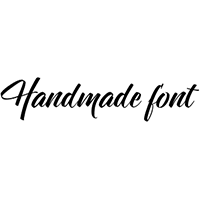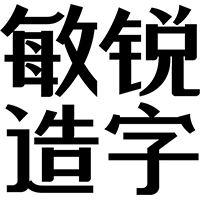TDC2 2010 – Text Faces

Now that I've covered the Type Systems, let's move on to the Text Faces category of the TDC2 2010 Type Design Competition. Judging text faces is always a tricky thing. Display type can go for sheer impact, but text type needs to be inconspicuous to a certain extent. How much personality is allowed to shine through before it distracts from the process of reading? Do we favour type that completely blends in – the proverbial crystal goblet many typographers keep referring to? Or do we seek that subtle but distinct sparkle that makes the reader "feel" he is reading an masterfully crafted typeface, and that puts a smile on our face when we put the book or magazine down? I have this theory about film scores – said theory came to me intuitively and is not backed up by any scientific evidence, mind you. When you watch a movie and the score is poor, you notice. When the score is good you stop noticing, because the music perfectly merges with the images. But when the score is exceptional, you notice again. And this is the kind of thing I am looking for. Because FF Quadraat made reading Rick Poynor's Obey The Giant – Life In The Image World even more enjoyable. Because Uncut became a less exciting read after they ditched FB Californian in favour of middle-of-the-road Minion. Because reading that one novel was such a smooth experience thanks to Dolly.
Regardless of the quality of the designs, one thing that struck me is that all the awarded text faces are revivals or interpretations of historic models, making this a rather oldish, conservative selection. This is a bit sad, because you could consider an awards list to be a reflection of the composition of the jury. No contemporary or truly new design was deemed worthy of an accolade. Yet many type designers out there are breaking new ground and advancing type design in exciting uncharted territories. I hope this year's TDC2 doesn't send out the wrong message.

Espinosa Nova
Espinosa Nova is a typeface that has been long in the making – the oldest files date from 2001. It all started as Cristóbal Henestrosa's bachelor's degree thesis about Antonio de Espinosa, which was subsequently published as a book: Espinosa. Rescate de una tipografía novohispana, México, Designio, 2005 (ISBN:968-5852-04-9). It won first prize at the Second National Design Biennial organised by the National Fine Arts Institute, the National Council for Culture and Arts (Conaculta) and the National Association of Graphic Design Schools (Encuadre). Antonio de Espinosa was the second Mexican printer, and most likely the first punchcutter of the New World. His work had largely been ignored by European type designers and type historians – there are many Garamonds, Baskervilles, Bodonis, but there is not even a single version of Espinosa.
The idea was to make a revival based on the work of Espinosa. A first version of the regular – simply called Espinosa – was finished in 2002. An italic followed in 2005, when Cristóbal studied a master in type design at Centro de Estudios Gestalt (Veracruz, Mexico). Then the project went on a hiatus: between 2006 and 2007 he designed Fondo, commissioned by the Fondo de Cultura Económica, the most important publishing house in Mexico. Cristóbal considers his second typeface really his first mature work. It went on to win a Certificate of Excellence in Type Design at TDC2 2008. After this two-year break Cristóbal wanted to start on a new Espinosa. The original design was the best work he could make in 2005. However he felt that in 2008 – after his work on Fondo – he could come up with something much better. So Cristóbal shelved the first version and started again from scratch.

Espinosa Nova now is an OpenType family of six fonts, consisting of three text styles (Regular, Italic, and Bold), a Rotunda, a Titling face, and an Ornaments font. The italic is more than just a companion to the Regular weight. Instead of merely providing emphasis, and going back to its historic function, it is a design in its own right that can be used independently for setting long texts and even entire books. The same applies for the Rotunda, a very common style in Spain and Mexico in the mid-sixteenth century. It can be used as a bold alternate, a concept also found in Robert Bringhurst's The Elements of Typographic Style. Making this type of family work was like attempting to have an unusual, non-evident harmony. Cristóbal tried to keep it that way by having the same x-height for all the variants, but different ascenders and descenders.
Cristóbal Henestrosa has this to say about his revival:
For me, making a revival is a great responsibility. Many people think that the digital versions of vintage typefaces are exactly the same as those printed in the old books. They believe that Robert Slimbach's gorgeous interpretation of Garamond is actually 100% Claude Garamond, which it isn't. So I wanted to do a very praiseworthy revival, in order to honor the Espinosa's skills. At this moment I am busy finishing a number custom projects, but I guess it is safe to assume that Espinosa Nova will be released in the Spring or Summer of 2010.

I was fortunate to receive a review copy of the fonts, and boy does this family look good. It is a lean, no-frills collection with everything a designer/typographer needs (and that doesn't include a Bold Italic, don't you let anybody tell you any different). The OpenType fonts come fully equipped, each with small caps (except the Rotunda), an extended ligature set, several sets of numerals, a number of alternate glyphs, and so on. The main concession Cristóbal made to contemporary users is the addition of small caps to the Italic and Bold weights as well. The Ornament font allows the user to create beautiful background patterns and frames, and also includes pointing fists and stand-alone ornaments. Surprisingly the Titling variant isn't an optical design, but a version that automatically creates frames around the letters, very nifty. And despite not really being a fan of blackletter designs, I find that Rotunda simply lovely and deliciously crunchy.
My take on revivals is that they can be faithful, but never should be slavish. I have little patience for type designers who fail to get into the mindset of the original designer. The best they can hope to produce are flaccid facsimiles. The very best revivals are those that are designed as if the original designer lived today, and had access to current type design and production tools. Espinosa Nova does this really well. It is a living, breathing design, with just the right amount of variations in the character shapes. In combination with the alternating sharp and rounded corners and confident curves, this produces a text image that is nice and crisp, with a hand-cut feeling, but leaves no doubt this is a contemporary interpretation. I think this may very well be my favourite of the four winners in this category.

Joos
This doesn't take away from the fact that I like Joos almost just as much. It is another revival, of a face by Joos Lambrecht – from my home town Gent – one of the first important printers and punchcutters of the sixteenth century. He outright criticised the reading habits and the typographic preferences of the Dutch and Flemish readers of that period. From 1530 on he tried to promote the use of roman faces instead of blackletter types, albeit with little success. Lambrecht published the first dictionary of the Dutch-Flemish languages, as well as a collection of "wise, crazy and amorous" poems, some of which were regarded as heretical. Eventually his conversion to Protestantism forced him to flee to Germany. Lambrecht cut many roman types which he tried to distribute to other printers, but also a remarkable upright italic for his personal and exclusive use. It is this italic that inspired the Joos typeface.
The design by Laurent Bourcellier is not a formal revival of Lambrecht's work, but faithfully interprets its core idea – an idealised roman face bringing together the characteristic graceful shapes of italics and the upright angle of romans. Joos takes its inspiration from the principles of classic italics such as the ones by Francesco Griffo, but also from more contemporary shapes. In order to render the letters optically vertical, it was necessary to apply a specific angle to each character; an angle defined by the character's structure and dimensions. In accordance with Lambrecht's concept, all the capitals are geometrically perpendicular, while the lowercase letters have an angle varying from 0 to 2 degrees. The low contrast between the thick and thin strokes allows for setting Joos in small sizes. Joos offers a wide typographic range of use and flexibility: ligatures, alternates, stylistic sets, OpenType functionalities, oldstyle figures, small caps for the Pro version, and so on. Anchored in history, Joos is a contemporary typeface, both technically and from an aesthetic point of view.
This typeface as well conforms to my personal opinion of what a good revival should look like. Again the designer – in this case Laurent Bourcellier – used the concept of the typeface, not its shapes, as a starting point for the design. Laurent managed to "get" what this typeface is about, with a far more interesting end result. If I had to describe Joos with only one adjective, it would be "cute", and I don't mean this in a denigrating way. The design is incredibly lovely, its generous forms warm and inviting, rounded and soft without being tacky. I find it very enjoyable to read, and the ligatures and alternates add the right amount of playfulness. If there were a typographic equivalent for the rising sun caressing the morning dew on spring leaves, or for the small warm hand of my five-year old daughter holding mine, this would be it.

ITC Legacy Square Serif
ITC Legacy Square Serif and ITC Legacy Serif Condensed join the ITC Legacy Serif, ITC Legacy Sans, and ITC Legacy Sans Condensed suites of typefaces to create an extended and versatile type system. Only ITC Legacy Square Serif was submitted to the TDC2type design competition and won the Certificate for Excellence in Type Design.
The idea of designing a square serif Legacy was the result of a "Eureka!" moment. It suddenly came to Ron Arnholm, out of the blue, that a square serif design was needed to round out the ITC Legacy family. As with all his earlier designs, Arnholm began by making pencil sketches of the basic alphabet. He explains:
This is the only way for me to get a feel for a letterform. It provides me with a constant, tactile feedback of the design process. In some ways, I find that paper and pencil are more important tools in creating typefaces than the design software in my computer.

Many of the lowercase foot serifs in the 1470 Nicholas Jenson typeface, which Arnholm used as a foundation for the Legacy family are asymmetrical. Their slab serif shapes are longer on the right, with minimal bracketing, while those on the left are much shorter, are tapered and are much more bracketed. Arnholm continued this design metaphor in his new square serif design. This serif treatment, while it resembles that of the Jenson model, is actually crisper because the serifs have square corners. At small sizes, the corners appear to soften, and as a result, the design does not assert itself as a "square serif" style. This makes it an ideal text face that melds with the other Legacy family fonts in perfect harmony. As the type approaches display sizes, however, its distinct personality shines through. Arnholm was also careful to match the overall colour, weight, and humanist diagonal stress of his earlier sans and serif versions of the family.



The design of the italic was a particular challenge for Arnholm in that he did not want a copy of the Legacy Serif italics, but still wanted to maintain the Renaissance influence in the new designs. His experience as a calligrapher helped him to overcome this hurdle. The resulting design is a cursive old style italic containing a vestige of the 16th-century Garamond italics. It is a robust design, and yet the lowercase words flow beautifully at all sizes.


Like the other designs in the ITC Legacy family, ITC Legacy Square Serif are available as feature OpenType Pro fonts, including small caps for the text weights (up to and including Medium), standard ligatures, several sets of numerals, and extended language support. For as long as I know ITC Legacy – almost twenty years now – I am still unsure about it, and I don't think the new Square Serif variant will convince me. You could argue it is a professional rendition of Nicholas Jenson's classic typeface, fit for the modern age. Yet I can't shake the feeling it is a bit too slick. When compared to Robert Slimbach's stunning Adobe Jenson, or the classic, lovingly cut Centaur, or Randy Jones' surprising interpretation Eason, or the radical re-imagining of Vendetta; ITC Legacy looks like it has been sandpapered a little too much. I'd compare it to a blockbuster – solid movie fare with high production values, very enjoyable to watch. Yet afterwards you may experience a guilty feeling and wonder if those two hours were perhaps better spent watching a movie with a little more substance; one that touches you and gives you food for thought. One that lasts beyond its end credits.

Rieven Uncial
If a sans serif roman and an uncial got together and had a type-baby, it would be Rieven Uncial. While Rieven retains a richness and elegance found in traditional uncial forms, it has been carefully tempered by designer Steven Skaggs to be much more versatile. The accompanying Italic works perfectly well with its uncial cousin despite being structurally quite distinct from it.
Rieven started as some sketches Steven made in 2003. He has always been an admirer of Victor Hammer's American Uncial but almost never found a way to use it because it is quite decorative. And other uncials are even more decorative. What he likes about the potential of uncials is the horizontal linear stress coupled with the round, open counters. So the idea for Rieven was to make a truly versatile and functional text face which would nevertheless possess some of the admirable attributes of uncial. Of course, a truly historical uncial is a majuscule letter. But following Hammer's lead one could devise a set of capitals that were largely Roman and use the lower case to impart the uncial-esque features. By 2005 Steven had drawn out the uncial lower case and caps and was testing them in text. As it evolved, the face became a kind of sans-serif/serif hybrid, and also a roman/uncial hybrid.
Then the face sat in the bowels of Steven's Mac for four years. He was looking for a partner who was good at getting the metrics set up and doing the hinting. Through mutual friend Brian Allen, Steven was referred to Delve. In early 2009 they began a partnership for the production of Rieven and release through Delve Fonts. Working with Delve proved to be an absolute joy. Throughout 2009 Steven and him exchanged drawings, Steven working in Louisville and emailing outlines to Delve in Berkeley. Delve would put the Illustrator outlines into Font Lab and email Steven proofs for review.
In the summer of 2009 Steven became convinced that if it were to be truly useful, the typeface would need an italic. This posed an interesting problem. The uncial form does not lend itself to italicisation. You can't just put a slant on it and there is no historical precedent for a cursive form or an "uncial italic." In the end, he decided to take advantage of the fact that Rieven is really a hybrid roman/uncial. He designed an italic that would be virtually a roman's italic. But to allow it to blend with the uncialised roman of Rieven, it has almost no slant (5 degrees). Instead, it gets its contrast from a pretty extreme condensing of the set width so that the visual vibration inherent in italics and cursives is introduced through the narrowness of the counters which counter-charge with the strokes. One other allowance was made to the uncial: there is a bit of trickery in making the italic "feel" as if it is a high-branching form like the uncial, but in actuality, the branching happens from the base of the letter forms. By these means, Steven was able to make an italic that stands alone as a typeface, but also blends in text setting with the uncial.
Steven says:
The warmth with which Rieven's birth has been greeted has encouraged us to go ahead with light and bold variants. We also intend to include a large number of specialty glyphs with these fonts to make them adaptable to all kinds of uses.
I don't want this to reflect negatively on this typeface, but I generally dislike uncial designs, which makes me not the best person to comment on Rieven Uncial. This is purely a matter of taste, and unfortunately I can't get past my distaste of this type of faces to be able to evaluate the design objectively. I'd hate to give Rieven Uncial an unfavourable review for the wrong reasons.


































 闽公网安备35010202000240号
闽公网安备35010202000240号